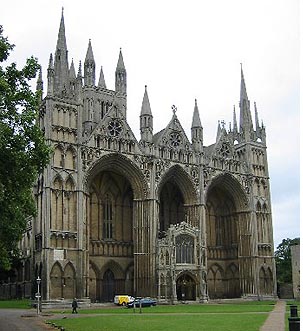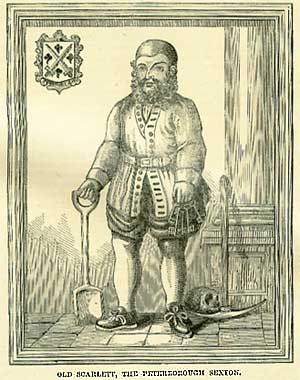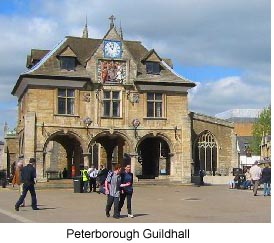Old Scarlett: The Gravedigger of Peterborough
by John Reed
Visitors to Britain's cathedrals and churches are accustomed to seeing memorials to nobility and royalty, but it is rare to find monuments to people of a more humble background. This is not the case in the East Anglian cathedral city of Peterborough, where a gravedigger by the name of "Old Scarlett" is something of a local folk hero.
Robert Scarlett died in 1594 at the age of 98, having spent much of his life as the sexton at Peterborough Cathedral. Not only does his memory live on in a portrait above the great West door of the 12th Century cathedral, but he also enjoys the distinctly English honor of having a Peterborough pub, the "Old Scarlett", named after him. Legend suggests that he may have been the inspiration for the gravedigger in Shakespeare's Hamlet. That is pure speculation, but there is no doubt about his main claim to fame -- that during his long career he buried two queens in the cathedral: Katherine of Aragon and Mary, Queen of Scots.
Old Scarlett's contribution is just one of many to the rich history of this location, which since the 7th Century has seen not just royal burials, but Danish and Norman invasions, fire in the 12th Century, the Dissolution of the Monasteries, vandalism and destruction during the English Civil War and another serious fire as recently as 2001. Despite this rich history, and being a fine example of Norman and early English architecture, most travelers pass by this town -- and its cathedral -- on their way from London to points north.
Rising from the Ashes
Situated some 80 miles north of London and originally called Medehamstede, the town grew around a Benedictine abbey founded in 655 by Paeda, King of Mercia. This original abbey was destroyed by the Danes in 870, and it was over 100 years until a new abbey, dedicated to St. Peter, was established. As the surrounding town grew around the new building, it took a new name from the abbey: Peterburgh. In 1070, much of Peterborough was destroyed during fighting between William the Conqueror's invading Norman armies and local Anglo-Saxons. The abbey survived that conflict, but succumbed to fire in 1116, which led to construction of a third abbey, the current building, starting in 1118 but taking 120 years to complete.
 Situated in the heart of the city, the cathedral sits within attractive precincts, which offer a peaceful haven from the bustle of the city outside. Upon entering the precincts, many visitors stop in their tracks, overwhelmed by the size of the building and the stunning view of the three impressive arches of the cathedral's West Front. Restoration in recent years has successfully removed much of the sooty grime and revealed the fine sandy coloring of the local Barnack stone from which the entire cathedral is constructed.
Situated in the heart of the city, the cathedral sits within attractive precincts, which offer a peaceful haven from the bustle of the city outside. Upon entering the precincts, many visitors stop in their tracks, overwhelmed by the size of the building and the stunning view of the three impressive arches of the cathedral's West Front. Restoration in recent years has successfully removed much of the sooty grime and revealed the fine sandy coloring of the local Barnack stone from which the entire cathedral is constructed.
Entering the West doors, the visitor is struck by the limited amount of stained glass and grand statuary on display. That is thanks to a spree of vandalism by Oliver Cromwell and his parliamentarian troops when they paid a visit in 1643, sadly destroying many of the building's early treasures. There was some measure of divine retribution for this attack, as one of Cromwell's soldiers fired his musket at the roof and was blinded when his own shot rebounded and hit him.
The impressive nave is a large, airy space, whose three-tiered arch construction of the Norman period will be familiar to those who have visited the cathedrals at Ely or Norwich. The ceiling of the nave is covered in a pattern of geometric shapes featuring hand painted figures. Dating from the 12th Century, it is one of the oldest painted ceilings in Europe. A large mirror has thoughtfully been provided to enable visitors to study the ceiling without incurring too much neck discomfort. Placing a coin in a nearby slot provides not only a few minutes of additional illumination but also a welcome boost to the cathedral coffers.
The fine detail of the ceiling was revealed by a major project, started in 1996, to fully restore the cathedral. The restoration was almost complete when, in November 2001, the cathedral was struck by fire, started deliberately when someone placed a candle under a stack of chairs. Luckily, the blaze was spotted in time and brought under control, but not before it had caused many millions of pounds of damage. The people of Peterborough responded with great generosity, raising the money to once again clean and restore the building to its former glory.
A Lifetime of Digging Graves
From its lofty perch above the main doors, Old Scarlett's portrait witnessed this latest episode in the cathedral's eventful history. Next to the portrait are these words:
"You see old Scarlitt's picture stand on hie,
But at your feete here doth his body lye.
His gravestone doth his age and Death time show,
His office by thes tokens you may know.
Second to none for strength and sturdye limm,
A Scarebabe mighty voice with visage grim.
Hee had interd two Queenes within this place
And this townes Householders in his lives space
Twice over: But at length his own time came;
What for others did for him the same
Was done: No doubt his soule doth live for aye
In heaven: Tho here his body clad in clay".
It may seem far fetched to suggest that Old Scarlett buried two people from every Peterborough household during his life, but as the population at this time was probably around 1,500, and Peterborough saw its first outbreak of plague in 1574, he may well have accomplished that feat in his 98 years, especially given his "strength and sturdye limm"
 Old Scarlett's first royal funeral duty came in 1536, when he buried Katherine of Aragon, Henry VIII's first wife. It was Katherine's inability to provide Henry with a male heir that led to the break with Rome and establishment of the Church of England, after Pope Clement VII refused to annul the marriage. Katherine never recognized Henry's divorce, and was exiled from the Royal Court in 1534. She died just two years later at Kimbolton Castle, and was brought to the abbey at nearby Peterborough for burial. Her remains still lie in the cathedral's North Aisle. Were it not for Katherine, the history of Peterborough and its cathedral may have followed a very different path, for it is widely believed that the church was spared when Henry dissolved the monasteries because it was her final resting place.
Old Scarlett's first royal funeral duty came in 1536, when he buried Katherine of Aragon, Henry VIII's first wife. It was Katherine's inability to provide Henry with a male heir that led to the break with Rome and establishment of the Church of England, after Pope Clement VII refused to annul the marriage. Katherine never recognized Henry's divorce, and was exiled from the Royal Court in 1534. She died just two years later at Kimbolton Castle, and was brought to the abbey at nearby Peterborough for burial. Her remains still lie in the cathedral's North Aisle. Were it not for Katherine, the history of Peterborough and its cathedral may have followed a very different path, for it is widely believed that the church was spared when Henry dissolved the monasteries because it was her final resting place.
In 1541 a new diocese of Peterborough was created, the abbey became a cathedral, and Peterborough became a city. Henry even started a school for the education of the cathedral choirboys. More than 450 years later, The King's School is still thriving. Originally located in the cathedral precincts, it moved to larger premises elsewhere in the city in the 19th Century, but still has close links with the cathedral, and its hundreds of pupils, in their distinctive maroon uniforms, can regularly be seen walking from the school to the cathedral to attend ceremonies.
Scarlett really was old, in his 90s, when he was next called upon to inter a monarch. After years of suspicion and alleged plots, Queen Elizabeth I finally lost patience with her Catholic rival, Mary, Queen of Scots. Implicated in the Babington Plot to murder Elizabeth, Mary was tried for treason, found guilty, and executed at Fotheringhay Castle, some twelve miles to the West of Peterborough, in February 1587. She was buried in the South Choir Aisle, but her remains were later moved to Westminster Abbey by her son, James I of England. The site of her original grave can still be seen in the cathedral.
In 1594, after a lifetime of digging graves for other people, Old Scarlett finally got a grave of his own, just two years short of his hundredth birthday. He had lived in a century of turmoil, and thanks to his job he was not a mere witness to the reigns of Henry VIII and Elizabeth I, but saw first hand the impact of their rule. His contribution will never be forgotten, as his portrait looks down upon those entering and leaving the cathedral, with his spade in one hand, his keys in the other, and a skull lying at his feet.
Away from Scarlett's portrait at the Eastern end of the cathedral, is the so-called "new building", which was completed in the early 16th Century, and features a fine fan vaulted ceiling. As well as the interior, the surroundings of the cathedral are worth exploring, including the many fine buildings in the precincts, the remains of the monastic cloisters that were destroyed by Cromwell's men, and the graveyard, where one can imagine Old Scarlett hard at work.
More to See...
 The cathedral is not the only place of interest in Peterborough. Leaving the precincts through the stone arch of the West gate, one enters Cathedral Square, at the heart of the city center. This pedestrian-friendly square was home to the city's market for hundreds of years until it relocated to a larger site in the 1960s. It provides a clash of old and new, bordered by a large modern shopping center but also featuring the 15th Century church of St. John the Baptist and the fine 17th Century Guildhall. Every year, just before Christmas, the square reverts to its old role, as a large continental market attracts vendors from as far as France, Belgium and Holland selling gourmet treats, and an old-fashioned carousel entices youngsters.
The cathedral is not the only place of interest in Peterborough. Leaving the precincts through the stone arch of the West gate, one enters Cathedral Square, at the heart of the city center. This pedestrian-friendly square was home to the city's market for hundreds of years until it relocated to a larger site in the 1960s. It provides a clash of old and new, bordered by a large modern shopping center but also featuring the 15th Century church of St. John the Baptist and the fine 17th Century Guildhall. Every year, just before Christmas, the square reverts to its old role, as a large continental market attracts vendors from as far as France, Belgium and Holland selling gourmet treats, and an old-fashioned carousel entices youngsters.
Nearby, one can also find Peterborough Museum and Art Gallery, which has a small but diverse collection, with notable items being displays on poet John Clare, who lived locally in the village of Helpston, some of the many Roman remains found locally, and an extensive collection of craft items made from bone and straw by Napoleonic prisoners-ofΠwar who were held near the city in the late 18th Century.
All of these attractions are within a few minutes walk of Peterborough's railway station, and make a rewarding detour for anyone willing to stop here awhile.
More Information:
We regret that we no longer have the resources to maintain up-to-date links and/or hours and pricing details for the various sites and attractions listed on this website. For more information about the location(s) listed above, please use your favorite search engine or visit Wikipedia.
John Reed has been resident in the USA for six years, but regularly returns to England, where he was born. He is particularly fond of his native East Anglia and of London, where he lived for many years. He writes on a variety of travel topics, and is especially interested in historical destinations off the beaten path.
Article and photos © 2005 John Reed
Portrait of Old Scarlett from Chambers' Book of Days, courtesy of the Emmitsburg Historical Society
|
